The Goddess of Christmas
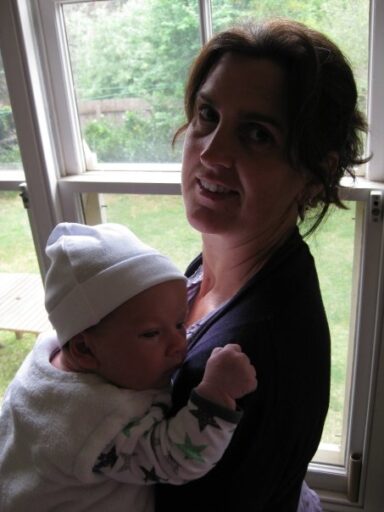
You might have read the parallels between Jesus and the living-dying gods of the Mediterranean. These gods were the son-lover of the preeminent goddess who died and was resurrected by the goddess.
Does this sound vaguely familiar?
Christmas is a living tradition that has continued, evolving with humanity for thousands of years.
At this time of year, the secrets of our ancient Great Mother are hidden in plain sight. Christmas is a remnant of ancient mythology from all over the world that honoured the great birth mysteries. Solstice and Christmas are part of one cosmic birth mystery that was gradually eclipsed by a male story.
In the Northern Hemisphere, the magic portal of the winter solstice has been celebrated for millennia as a birthing mother. Solstice is a bio-magical event, not just a passage of the seasons. The winter solstice in the Northern Hemisphere is a sacred time, a geomantic womb where the Great Earth Mother gives birth to another solar cycle. The descent into darkness is a magic portal.
In her article ‘The Solstice-Nativity Continuum’, Seren Bertrand explains the significance of Christmas in the Northern Hemisphere: “In old lore, the Solstice is the start of the birth event – the crowning of the light – and it is on December 24th/25th ‘the eve of the Christ child’ that the birth happens. After the light crowns through the cosmic-cervix on Solstice, we enter three days of sacred birth space, a luminous passageway within the womb-darkness, watching the light begin to emerge, as the birthing journey unfolds. When the light/child of light is born a great celebration happens – with feasting, singing, carousing, toasting, gift giving, family gatherings, spiritual gatherings, and joy and hope.”
In the Southern Hemisphere, where I am from, Christmas falls in mid-summer and so this time of year tends to be the anthesis of the darkest of times. We are in the peak of summer, with Christmas Day being a hot meal (as descendants of the UK) sitting incongruently in bellies playing cricket or swimming or sitting outside under shade from the bright sunshine.
But, as with the Northern Hemisphere, Christmas is still a deeply potent thread of the nativity story that is universal and resonates for both hemispheres.
This is the story of the miracle of birth.
If you read my blog ‘Who Is the First Goddess?’ you’ll have seen statuettes of the Great Mother that out number any other Palaeolithic and Neolithic imagery. According to Marija Gimbutas in her book ‘The Civilization of the Goddess: The World of Old Europe’, flint female figurines have been found dating to more than 500,000 years ago.
The earliest images of the Great Mother were of a voluptuous figure with large, abundant breasts and a full, pregnant belly. Her accentuated breasts were sacred as she was the life-giving, life-nourishing goddess. These women were celebrated for their sacred bodies, symbolising the earth as a mother who nourishes and provides plenty for her children.
The Great Earth Mother was a mother creatrix capable of protecting the crops from disease and weather and bringing abundance to the land and her people.
The Stages of a Woman’s Life
Marija Gimbutas categorises four main representations of the goddess. The first is the goddess who personifies the regenerative forces of nature. The second is the goddess who personifies the destructive forces of nature. She is “the Death Goddess, rendered as a stiff nude, a poisonous snake, or bird of prey; vulture, owl, raven, or crow”.
The third, the Goddess of Regeneration, controls the life cycles of the whole natural world. Marija Gimbutas tells us she is represented by “the uterus, pubic triangle, or foetus: toad, frog, hedgehog, bull head, triangle and double triangle. She also appears as an insect: bee, butterfly, moth.
She is the all-generating deity who bears and nourishes all of life, plant, animal and human. In the natural cycle of nature death and regeneration are inseparably connected. The Goddess of Death and Regeneration is one goddess who operates simultaneously.
The fourth main representation of the goddess is focused on the prehistoric male deities who, according to Marija Gimbutas, only make up 3-5% of Neolithic sculpture.
Marija Gimbutas describes “The Great Mother Goddess who gives birth to all creation out of the holy darkness of her womb became a metaphor for Nature herself, the cosmic giver and taker of life, ever able to renew Herself within the eternal cycle of life, death, and rebirth.” This is the dual aspect of the Goddess of Death and Regeneration, inseparably connected in nature, who represents the simultaneous function and cyclic continuum of these aspects.
In ‘The Language of the Goddess’, Marija Gimbutas tells us that the main theme of the Neolithic goddess was “the mystery of birth and death and the renewal of life, not only human but all life on earth and indeed the whole cosmos”. This Great Mother was the Giver of Life, Wielder of Death and Regeneratrix. The was the Earth Mother was the fertility goddess, rising and dying with the plants.
The Great Mother gives birth to all living and takes back to herself all that ever was. She holds us in continual change, constant impermanence and shows us the magic of generation and cyclic evolution.
Out of her sacred body she creates or destroys. She bleeds, grows life, harbours the unborn, gives birth, nurtures and feeds her young from her own magical, erotic, living body. She makes love, makes energy, makes life – all in the body. Since a woman’s body, which is so like the earth, makes enough food for her offspring, our early ancestors learned to trust the Mother.
The triple goddess represents the three stages of a woman’s life – the maiden, mother and crone. A woman’s life revolved around the sacred blood mysteries of menarche, childbirth, and menopause.
Menarche was the first monthly flow of blood. Childbirth was accompanied by blood from birthing. Menopause was when a woman’s wise blood remained inside her to give her wisdom.
These are still powerful phases for a woman that function as psychological gateways to the change in consciousness required by each new stage.
What Does This Have to Do with the Christian Nativity?
Can you see how these ancient threads were woven into a new Christian nativity story with Mother Mary as the cosmic birther?
The mother archetype is the sacred portal for creation. Women act as midwives for the soul’s entrance to the earth plane. She creates life and brings it through to have the experience of life. Women are the ultimate manifestors!
The mother’s experience of herself as the carrier and nurturer of life helped to define the image and qualities of the Great Mother who was the protector who nourished, contained and transformed all of life.
The cosmogonic goddess was represented in multiple forms and functioned for millennia as a multi-dimensional metaphor of the Sacred Source of life, the inevitability of death, and the promise of rebirth within the great recurring cycles of the natural world.
In the Christian version, Mother Mary a woman pregnant with possibility, patiently awaiting the birth of the avatar of the light, Jesus.
Although it has been distorted and overlayed by many other treads (Santa, gift giving turned into commercial mayhem) the nativity is essentially a myth that continues to carry incredible spiritual power. Whether we believe in a literal birth of Jesus or not, the story holds many empowering ancient threads of the Great Mother, reenacting the miracle of birth.
This iconography of the mother and baby is incredibly old. We might have seen the statues of Isis holding baby Horus on her lap and seen the similarities between this and the images of Mother Mary holding baby Jesus.
But this image goes much further back.
The Great Mother
The cultures of Old Europe, Old Anatolia and the Mediterranean region created anthropomorphic and zoomorphic imagery. Many statues have survived that whisper of ritual practices for the seasons of Neolithic life. These zoomorphic sculptures may express kinship between the human and animal realms.
Mother and Baby from Hacilar Höyük (7000-5000 BCE)
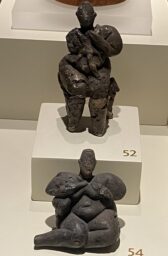
At the Anatolian Museum of Civilizations, Türkiye, I saw many figurines from Hacilar (7000-5000 BCE) depicting mothers with their babies. These are rare intact finds with fine details. The women, with their prominent aged breasts and belly, are thought to represent either a fertility mother goddess or an older woman who has achieved high status.
The display of female figurines from Hacilar in southwestern Turkïye, 23 km south of present-day Burdur. It has been dated back 7040 BCE. These figurines were tiny! There were a few mothers seated with their legs off to the side holding their babies against their chest. In the description we are told these goddesses are holding “boys”.
Their hands and feet are small, markedly out of proportion to their large breasts, belly and buttocks, with their hands placed lovingly under their breasts. These goddesses hold their breasts, a common representation at that time for the concept that the divine feminine was the nurturer of the world.
Ubaid Mother breastfeeding her child (c.4500-4000 BCE)
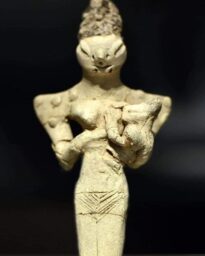
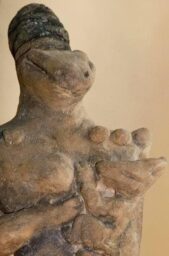
These statues were found at Ur, in modern-day Iraq, belonged to Ubaid Period (5500-3800 BCE). Archaeologists are unsure whether the heads of these goddesses are lizards or snakes. The one on the right looks like a frog to me. These intrigue and shock me. I find their elongated features and coffee bean eyes a bit alien.
Vinča Bear Mother with child (c.4500-4000 BCE)
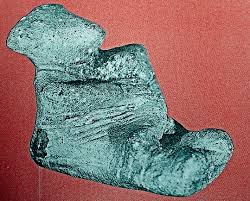
The Vinča culture, also known as Turdaș culture or Turdaș-Vinča culture, is the oldest Neolithic culture in South-eastern Europe. The Vinca culture flourished from 5,500-3,500 BCE on the territories of what is now Bosnia, Serbia, Romania and Macedonia.
The terracotta Vinča mother and baby (Fafos II, Kosovo) are either bears or humans wearing bear masks. The veneration of the bear as an ancestor is found throughout the northern hemisphere, and the association of the bear with the birth-giving mother is corroborated by the root bher, meaning to bear children.
The bear is most probably the oldest sacred animal of the Palaeolithic age. This statuette may be the earliest image of a mother with her young, and expresses tenderness of a mother for her child not seen in other Palaeolithic art.
Madonna from Gradac (c.5000 BCE)
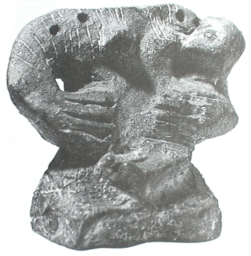 The seated Madonna from Gradac (Gradac, Morova valley, Kosovo, c. 5000 BCE) nurses a human baby that wears the triangular mask of a bird. Sadly the mother’s head has been lost.
The seated Madonna from Gradac (Gradac, Morova valley, Kosovo, c. 5000 BCE) nurses a human baby that wears the triangular mask of a bird. Sadly the mother’s head has been lost.
The sculptor put a lot of thought into the iconography of this piece. Her back is incised with chevrons, often found on the bird-woman image. Her hips are covered with a net design, associated with the waters of life.
Sesklo Enthroned Goddess and Child (4800-4500 BCE)
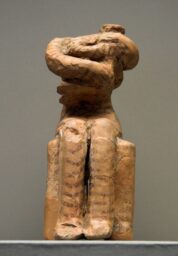
A terracotta figure from Sesklo, Thessaly, Mycenae, seated on a throne wearing a costume covered with serpentine lines, holds a baby that resembles a snake.
Painted red parallel lines coil around their bodies, swirling at the womb area. This might imply the initial transmission of culture between mother and child through this maternal embrace.
This statue might be the earliest image of the snake goddess who is found in Neolithic cultures in Old Europe, Ur in Mesopotamia and Mehrgarh in the Indus Valley.
There are countless other ancient examples of a mother and child. Another figurine shows a mother holding child in her arms from the Vinca culture of Drenovac, Serbia, dated (c.5000-4000 BCE). The mother’s eyes are like coffee beans, possibly signifying a trance or vision-dream state. A female figurine of a woman holding a baby has only survived as a torso from earliest Neolithic culture of Europe – the Sesklo culture of Greece (6850-4400 BCE).
I am still trying to wrap my head around the ancient goddesses who were hybrids of animals and humans. The mother and child, whether bear, bird, serpent, lioness, or cow, gives us the dual image of the Great Mother as source and what comes from source – the child as the constantly renewed cycle of life. These images usually have a human head, and the body of an animal or bird wings but could also be the other way around.
The later image of the human goddess mother and child celebrating the mystery of birth is common to all civilisations from Cretan goddess holding up her child to the Egyptian goddess Isis with her child breastfeeding.
Any mother will resonate with the image of Mother Mary cradling her newborn baby in her arms with the unconditional love of her new babe emanating out from her. This experience is like nothing else I have ever experienced. This is an eternal, expansive, fierce love that knows no bounds. No mother can truly connect with the nativity of Christmas and not be transported back to that moment with their own baby.
Birth is a miracle. When the excruciating agony subsides and the new soul who has been created deep within suddenly erupts into the world and cries their greeting. The baby is placed on our chest, and we take in their perfect little fingers and toes, glowing with unimaginable newness. It is easy to imagine a chorus of angels singing in the background and all the ascended masters, gods and goddesses breathing a sigh in unison.
Now we can reclaim the other threads in the Christmas nativity story of the Great Mother Goddess, the Creator of all. We can honour her as the one who births, feeds and keeps us safe from harm.
From this perspective, Christmas is a living tradition that has continued, evolving with humanity for thousands of years.
On Christmas Day I honour Mother Mary – the mother of mothers! Let’s not forget the journey she went through and all of the mystery and magic surrounding her on this day.
Motherhood is one of the deepest, most excruciating, most ecstatic portals for LOVE! Women are the sacred portal for creation. Women create life and bring it through to the earth plane. Women are the ultimate manifestors!
Women – mothers – have experienced the excruciating rigors of committing to love NO MATTER WHAT. These are the women who choose love over and over again!
Mothers have chosen a path that often – always? – includes sacrificing her own needs and wishes, over and over again. She is asked to put another being’s needs above her own, committing to love NO MATTER WHAT. She chooses love over and over again!
This takes place from conception with each and every single choice we make for the benefit of another being over ourselves. None more so than Mary.
I hope you find space to pause, to celebrate Mother Mary today. Motherhood is one of the deepest most excruciating most ecstatic portals for LOVE! You are a portal for LOVE expressed and experienced on the earth plane!
Honour your motherhood.
Honour the sacrifices you have made.
Honour that you chose love over and over again!
And love yourself for it!
Stay tuned for part 3 about the Goddesses of Egypt, including the goddess the early Christians used to create the iconography of Mother Mary.
